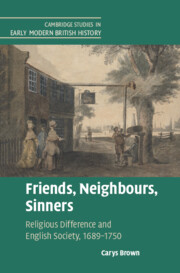Book contents
- Friends, Neighbours, Sinners
- Cambridge Studies in Early Modern British History
- Friends, Neighbours, Sinners
- Copyright page
- Contents
- Figures
- Acknowledgements
- Note on the Text
- Abbreviations
- Introduction
- Chapter 1 Reframing Religious Difference
- Chapter 2 Public Religion
- Chapter 3 Politeness and Hypocrisy
- Chapter 4 Drinking, Dancing, Talking
- Chapter 5 Neighbours, Friends, Company
- Conclusion
- Bibliography
- Index
Chapter 1 - Reframing Religious Difference
Published online by Cambridge University Press: 21 July 2022
- Friends, Neighbours, Sinners
- Cambridge Studies in Early Modern British History
- Friends, Neighbours, Sinners
- Copyright page
- Contents
- Figures
- Acknowledgements
- Note on the Text
- Abbreviations
- Introduction
- Chapter 1 Reframing Religious Difference
- Chapter 2 Public Religion
- Chapter 3 Politeness and Hypocrisy
- Chapter 4 Drinking, Dancing, Talking
- Chapter 5 Neighbours, Friends, Company
- Conclusion
- Bibliography
- Index
Summary
Chapter 1 explores the process of adjusting to England's new and uncertain religious settlement, and the broader impact that this process had on the way that religious differences were discussed. It does so by seeking answers to two questions. First, why was the legislation of 1689 an inadequate framework for managing religious difference? Secondly, how did contemporaries seek to overcome these perceived inadequacies? Through exploring these questions, it becomes apparent that adaptation to toleration involved the development of rhetorical strategies – particularly in contemporary print – that set up oppositions between Church and Dissent not just in political or religious terms, but also in terms of social status and behaviour. As the process of coming to terms with toleration unfolded, therefore, religious difference came to shape the developing social and cultural norms of the period.
- Type
- Chapter
- Information
- Friends, Neighbours, SinnersReligious Difference and English Society, 1689–1750, pp. 30 - 68Publisher: Cambridge University PressPrint publication year: 2022

